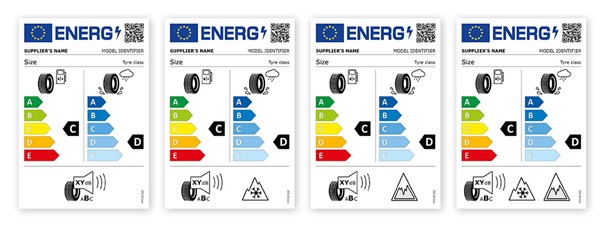Tyre label information - REGULATION EU 2020/740
Tyre label
EU tyre labelling rules help consumers make an informed purchase decision when they replace their tyres, as the label highlights the performance of the tyre on issues relating to fuel efficiency, safety and noise. At the same time, the labels drive manufacturers to innovate and strive to have their tyres classified in the top classes in the different categories.
New labelling rules, applying from 1 May 2021, are set out under Regulation (EU) 2020/740. This replaced the previous Regulation (EC) No 1222/2009, applicable from 2012, that first introduced the obligation of labelling car and van tyres. The new rules are extended to cover bus and truck tyres, and introduces options to show if the tyres are suitable for use in severe snow conditions or in extreme climatic situations.
In specific terms, tyre labels provide a clear and common classification of tyres performance for i) rolling resistance, ii) braking on wet surfaces and iii) external noise.
The rolling resistance in a tyre is an indicator of its energy efficiency which has an impact on fuel consumption.
Different tyres can have different rolling resistance for a number of reasons, including the design and structure but also the tread compounds (amount of silica or carbon-black). The tyre pressure also affects rolling resistance, as a pressure lower than prescribed results in higher rolling resistance. For all tyre manufacturers, the challenge is to find the lowest rolling resistance that is not detrimental to other parameters, in particular safety.
Low rolling resistance tyres that are properly inflated can have as much as a 10% savvings impact. This provides financial savings in terms of running costs or, for electric vehicles for example, enables the driver to cover a further distance before refuelling or recharging. The rolling resistance class ranges from A (most efficient) to E (least efficient). The higher the energy class, the lower the rolling resistance. (The previous label had a range from A to F.)
The wet grip class is a critical safety feature, relating to how a tyre can brake on wet roads. Tyres are rated A (the shortest braking distance) to E (the longest braking distance). The difference in each category can mean an extra 3-6 metres on the stopping distance.
The external noise relates to the noise produced by the tyre when a car passes by and is measured in dB (decibels). Noise classes range from A (less noise outside the vehicle) to B (more noise).

Under the new regulation, in addition to information on rolling resistance, breaking on wet surface and external noise, and the classes, the tyre label may display 2 additional parameters:
- Winter tyres approved for use in severe snow conditions carry a specific pictogram, called the « Alpine symbol » or 3PMSF (3 peaks mountain with snow flake). To have the pictogram the tyre has to pass a specific test for braking on a road with snow. The same pictogram appears on the tyre sidewall.
- Nordic winter tyres approved for use in extremely cold conditions also carry a specific pictogram, representing an ice stalagmite. To bear the pictogram, the tyre has to pass a specific test for braking on extreme ice. These tyres are only marketed in Nordic countries and should be used in extremely cold winter conditions. Usually, these tyres do not work well on a wet surface or in less severe winter conditions
Standardised tests are used to assess the performance of tyres in all the 5 parameters indicated on the label. Only tyres reaching a predetermined minimal performance level can carry the snow or ice symbol. National authorities perform random controls to check the accuracy of the performance levels.
In order to account for stocks of tyres produced before May 2021, car and van tyres bearing the old label may still be sold until the end of 2021.
Vehicle manufacturers also have to provide information on the tyres for that vehicle to customers.
Type-approval legislation
Tyres need to meet specific requirements to be placed on the European market, as outlined by Regulation (EC) No 661/2009 on general safety of motor vehicles. This legislation refers to the same testing methods for the same parameters on the tyre label and sets the minimal requirements for efficiency, safety and health protection.
As tyres have continuously improved in performance, and the requirements on the minimum performance level that can be placed on the EU single market have become stricter, tyres with the worst performance have progressively been outlawed. Therefore tyres with an energy class worse than E, with a wet grip class worse than E or with a noise class worse that B are banned from the European market.